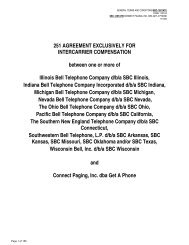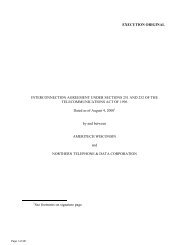Optical Telecommunications, Inc.
Optical Telecommunications, Inc.
Optical Telecommunications, Inc.
Create successful ePaper yourself
Turn your PDF publications into a flip-book with our unique Google optimized e-Paper software.
3.1 SITE CONTROL<br />
Version: 2Q05 Standard ICA<br />
07/06/05<br />
Attachment 10<br />
Page 4<br />
In the total loss of building use scenario, what likely exists will be a smoking pile of rubble. This<br />
rubble will contain many components that could be dangerous. It could also contain any<br />
personnel on the premises at the time of the disaster. For these reasons, the local fire marshal<br />
with the assistance of the police will control the site until the building is no longer a threat to<br />
surrounding properties and the companies have secured the site from the general public.<br />
During this time, the majority owner of the building should be arranging for a demolition<br />
contractor to mobilize to the site with the primary objective of reaching the cable entrance facility<br />
for a damage assessment. The results of this assessment would then dictate immediate plans for<br />
restoration, both short term and permanent.<br />
In a less catastrophic event, i.e., the building is still standing and the cable entrance facility is<br />
usable, the situation is more complex. The site will initially be controlled by local authorities<br />
until the threat to adjacent property has diminished. Once the site is returned to the control of the<br />
companies, the following events should occur.<br />
An initial assessment of the main building infrastructure systems (mechanical, electrical, fire and<br />
life safety, elevators, and others) will establish building needs. Once these needs are determined,<br />
the majority owner should lead the building restoration efforts. There may be situations where the<br />
site will not be totally restored within the confines of the building. The companies must<br />
individually determine their needs and jointly assess the cost of permanent restoration to<br />
determine the overall plan of action.<br />
Multiple restoration trailers from each company will result in the need for designated space and<br />
installation order. This layout and control is required to maximize the amount of restoration<br />
equipment that can be placed at the site, and the priority of placements.<br />
Care must be taken in this planning to ensure other restoration efforts have logistical access to the<br />
building. Major components of telephone and building equipment will need to be removed and<br />
replaced. A priority for this equipment must also be jointly established to facilitate overall site<br />
restoration. (Example: If the AC switchgear has sustained damage, this would be of the highest<br />
priority in order to regain power, lighting, and HVAC throughout the building.)<br />
If the site will not accommodate the required restoration equipment, the companies would then<br />
need to quickly arrange with local authorities for street closures, rights of way or other possible<br />
options available.<br />
3.2 ENVIRONMENTAL CONCERNS<br />
In the worse case scenario, many environmental concerns must be addressed. Along with<br />
the police and fire marshal, the state environmental protection department will be on site<br />
to monitor the situation.<br />
Items to be concerned with in a large central office building could include:<br />
1. Emergency engine fuel supply. Damage to the standby equipment and the fuel<br />
handling equipment could have created "spill" conditions that have to be handled<br />
within state and federal regulations.<br />
CCCS 251 of 261
















